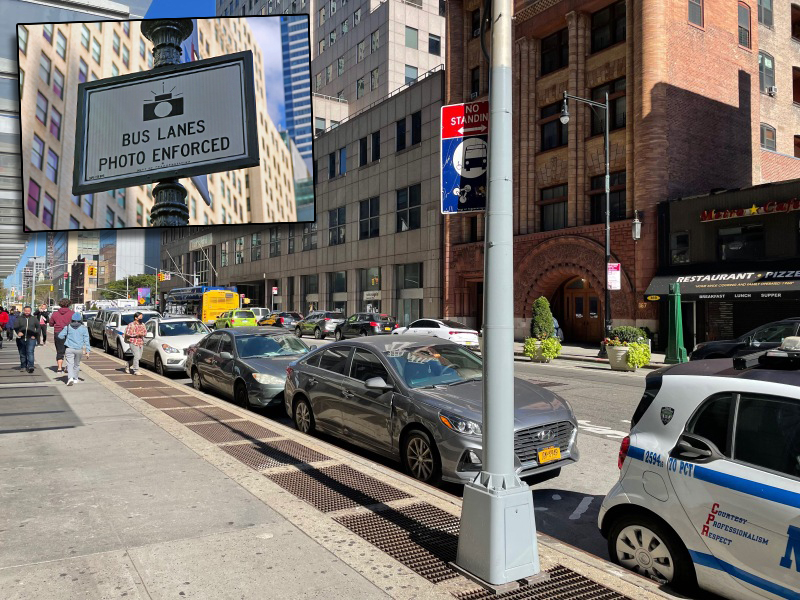Picture day is coming for double parkers and bus and bike lane blockers.
The MTA's hugely successful automated bus lane enforcement camera system — which currently only dings drivers who drive or park in bus lanes — will expand to include drivers who park in bus stops, truck loading zones, bike lanes, intersections, and crosswalks, according to newly drafted budget legislation agreed upon by Gov. Hochul and legislative leaders in Albany.
Drivers caught by bus-mounted cameras committing those infractions will be hit with a $50 ticket for their first offense, with escalating $50 fines up to $250 for each offense committed in a 12-month period, mimicking penalties for driver caught on camera in the bus lane.
The legislation comes after the MTA announced plans to expand the number of buses with on-board cameras from 450 to 1,000 by the end of the year. Automated enforcement on bus lanes has sped buses by 5 percent on routes where the MTA has deployed it since 2019, officials said last month.
"Camera-based enforcement is such a powerful tool for making our streets safer — it solves issues of bias and limited resources for on-the-ground ticketing, and most importantly, we know it changes behavior," said Sara Lind, the co-executive director of Open Plans.
"New York City should be taking advantage of every possible way to use it and we applaud state lawmakers for making that commitment."
Hochul proposed expanding the bus camera's jurisdiction beyond bus lanes last year, but the proposal died in negotiations with the legislature. This year, Albany lawmakers from the city included the proposal in their "Fix the MTA" package of bills that also proposed increasing service frequency and introducing free buses in New York City.
Assembly Member Zohran Mamdani (D-Astoria), the package's primary cheerleader, said the expanded camera program fit right in with its other priorities. Beyond the camera expansion, Mamdani's other wins included the creation of a two-year free bus pilot on one route in each borough, a smaller-than-planned fare hike, and $35 million for reduced headways on nights and weekends.
"The crux of this entire campaign is safeguarding the existence of a public good, and bringing it towards excellence, and you cannot have public transit be considered excellent, without service that is reliable and frequent," said Mamdani.
"It is so exciting to have [the camera expansion] paired with our wins in terms of fiscal investments, because we know that that will have a significant impact in terms of reducing the congestion that buses face, congestion which damns buses to running at speeds that are oftentimes slower than New Yorkers' pace when they're walking."
New York City buses currently crawl at an average of just 8.09 miles per hour. Automated bus cameras have been a boon to both bus operations and street safety, according to data recently released by the MTA that showed traffic crashes down by one-quarter on routes with camera-enforcement bus lanes.
Still, proponents had to overcome initial opposition this year from the state Assembly, which did not include the camera expansion in its budget proposal.
"The governor and the MTA led at the outset, the Senate was early to the party and the Assembly arrived just on time. And we are going to be a fairer, more efficient city because of this progress in the budget," said Riders Alliance Director of Policy and Communications Danny Pearlstein.
"Riders need fast and reliable bus service, and enforcement against cars that block the bus is a crucial part of that, both in the bus lane and beyond."
The state budget also included money to fill the MTA's fiscal hole — though leadership had to impatiently look down the tunnel for it like a subway train that just wouldn't come. The final deal didn't avoid a proposed fare hike this year, though the state will provide $65 million to knock the hike down from five percent to four percent, according to the legislation. That would result in a subway fare of $2.86 when the fare hike is instituted.
Hochul and state legislators also saddled New York City with paying for 50 percent of the cost of Access-A-Ride, or $165 million per year, and agreed to raise the highest level of the payroll mobility tax — but only on New York City-based employers, to the frustration of city pols including Mamdani.
"It's a misguided approach in funding what is a collective good, and I think it is indicative of how state government too often view cities as opposed to suburbs," he said.
In addition to the payroll tax hike, Gov. Hochul's proposal to fund the MTA with casino money also made it through the meat grinder of negotiations with the Assembly and State Senate, though in a different form than she first suggested.
Where Hochul's proposal sent all of the tax money from downstate casino licenses and casino revenue to the MTA, the lawmakers ultimately decided to send only half of the tax revenue from New York City casinos to the MTA and 40 percent of the revenue from downstate casinos outside of New York City to the MTA. The rest will fund eduction.
MTA CEO Janno Lieber didn't seem to mind that the suburbs got off the hook, however — telling reporters on Friday that commuter rail riders will still have to pay a fare hike.
"Long Islanders and people who use the commuter railroads are going to participate in the fare increase," Lieber told reporters on Friday when asked about the suburbs getting off scot-free.
"I don't like this whole separation between railroads and subway, city versus suburbs. Railroads are being used by New Yorkers more and more we dropped the fare to five bucks for anybody who wants to ride the railroad most of the day."






